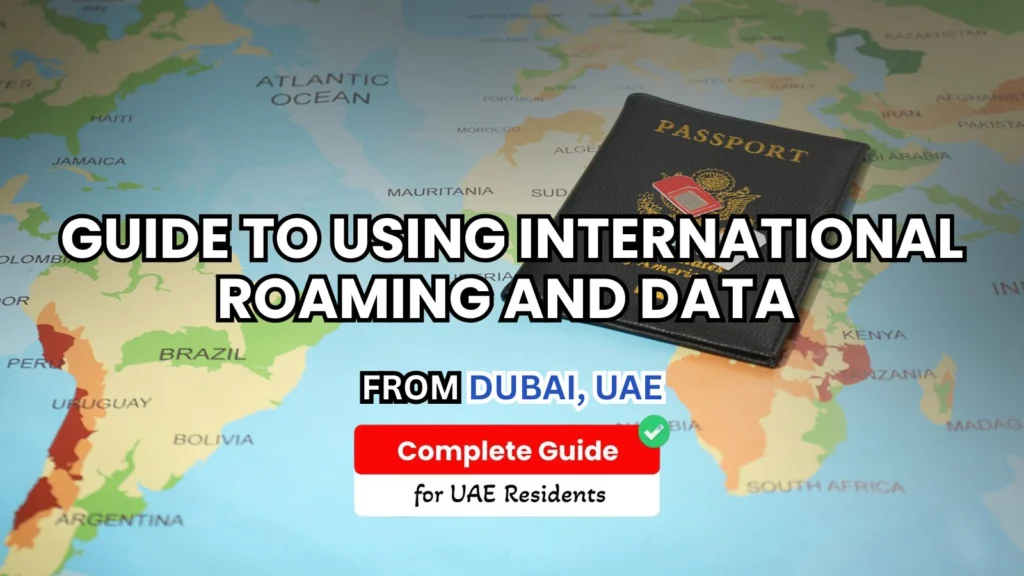
New city, new coffee, same question: how do you get online without wrecking your budget? You’ll want maps, ride-hailing, translations, and that sunset post you absolutely must share. Staying connected is part of modern travel, but roaming can bite. The goal here is simple—use your phone like a pro, not a payphone.
What roaming really is
Roaming lets your UAE SIM jump onto a foreign network. Your phone works almost the same, just on someone else’s towers. The catch? If you use data without a plan, you’re basically turning on a money tap. I’ve seen the “sticker shock” bill; it’s unforgettable and very avoidable.
Know your options
You’ve got three good routes:
-
UAE roaming bundles
-
Local tourist SIM at your destination
-
eSIM you install before you fly
Each one has a place. Pick based on trip length, how much data you need, and how much effort you’re willing to spend at the airport.
UAE roaming bundles
Most UAE providers offer easy roaming packs. The formats differ, but the idea’s the same: a fixed price for a set amount of data (and sometimes calls) across a list of countries.
-
Daily or weekly passes: great for short trips or when you’re city-hopping.
-
“Roam like home” plans: use your local minutes/data abroad in select countries.
-
Regional bundles: handy if you bounce around the GCC or one region often.
Why use them? Zero airport errands, your number stays active for OTPs, banking, and deliveries. I like these for quick business trips or weekends away when convenience beats saving every dirham.
Local tourist SIMs
This is the classic budget move. Land, grab a tourist SIM at the airport kiosk, and go.
Pros:
-
Usually the cheapest price per GB
-
Local number for food delivery and taxis
-
Plans designed for tourists—big data, short validity
Cons:
-
You’ll swap SIMs (keep your UAE one safe)
-
Some kiosks push pricier plans—ask what’s actually included
-
Minor setup time right after a long flight
I keep a tiny SIM tool on my keychain so I’m not digging through my bag at the counter.
eSIMs (the modern favorite)
No plastic. No tray. You buy online, scan a QR code, and your plan activates when you land. For multi-country trips, eSIMs feel like magic. You can even set it as “data only” and keep your UAE SIM active for calls and OTPs.
Tips from the road:
-
Install the eSIM over strong Wi-Fi before you fly.
-
Screenshot the QR code like it’s your boarding pass.
-
Set the eSIM as the data line and turn off data roaming on your UAE SIM to avoid accidental charges.
How to choose quickly
A simple rule-of-thumb:
-
3–5 days, light-to-medium data: daily UAE roaming pack.
-
7+ days or heavy data (navigation, reels, video calls): local SIM or eSIM.
-
Frequent flyer to the same region: a “roam like home” or regional bundle pays off.
If I’m traveling for work with tight schedules, I go roaming for speed. If I’m on holiday and streaming maps all day, eSIM wins.
Save your data (and your budget)
Little habits go a long way:
-
Download maps offline for all your cities.
-
Switch streaming apps to “low data” mode.
-
Turn off background data for chatty apps.
-
Auto-upload photos on Wi-Fi only.
-
Use Wi-Fi for heavy tasks: backups, big downloads, updates.
Bonus move: pre-download your airline boarding passes and hotel confirmations to your wallet app. No signal panic at the gate.
Avoid hidden charges
Two sneaky pitfalls:
-
Forgetting to activate a plan: your phone then bills per MB. Ouch.
-
Auto-renew: some daily plans renew even if you barely used them. Turn off auto-renew when you don’t need a second day.
Also check the country list. “Global” doesn’t always mean every country. If your destination isn’t covered, switch to a local SIM or eSIM plan that is.
Keep your UAE number safe
Your UAE SIM is linked to banking, delivery apps, and Two-Factor codes. If you must remove it, stash it in a labeled sleeve in your passport wallet. If you use an eSIM for data, keep the UAE SIM in your phone for calls and OTPs, but toggle off its data roaming.
Security on public Wi-Fi
Public Wi-Fi is convenient but nosy. A few ground rules:
-
Avoid logging into banking on open networks.
-
Use a VPN if you need to access sensitive accounts.
-
Forget networks after use, and turn off auto-join.
-
Share files only over encrypted apps, not random hotspots.
Think of public Wi-Fi like a crowded café—keep valuable conversations quiet.
Quick pre-trip checklist
-
Confirm your destination is covered by your roaming plan (if using one).
-
Choose: roaming vs local SIM vs eSIM.
-
Install eSIM and test before you fly.
-
Download offline maps and transit apps.
-
Set data-saving on social and streaming apps.
-
Turn off background sync for non-essential apps.
-
Pack a SIM tool and a small zip sleeve for your UAE SIM.
-
Carry a power bank—navigation drains batteries fast.
When things go wrong
No data after landing? Toggle airplane mode for 30 seconds, then back. Check APN settings in your eSIM instructions. If you’re still stuck, select a different local network manually. Most plans list partner networks—try those first.
Data melting too fast? Open your phone’s data usage dashboard. You’ll spot the culprit in seconds—often cloud backups or auto-updates. Pause them until you’re on hotel Wi-Fi.
Small ways to stay sane
-
Keep screenshots of your plan details, especially plan name and expiry.
-
Rename your eSIM line to something obvious like “Japan Data” so you don’t mix it up later.
-
Set a daily data reminder alarm the first two days; once you know your rhythm, you can switch it off.
Final thoughts
Staying connected abroad doesn’t have to be expensive or complicated. Decide how much data you’ll really use, pick the option that fits your trip, and set your phone up before you board. With a few smart tweaks—offline maps, data limits, and a plan that matches your travel style—you’ll navigate, message, post, and book rides like a local. And you’ll come home with photos and memories, not a scary bill.
